At Best Cosmetic Hospitals, we understand that every individual’s journey toward self-confidence is unique. Cosmetic breast surgery offers an opportunity to enhance, reshape, and refine your breasts in a way that aligns with your personal aesthetic goals. Whether you’re seeking to increase volume, restore a youthful shape, or improve symmetry, cosmetic breast surgery allows you to feel confident in your body.
Cosmetic breast surgery has become one of the most popular categories of cosmetic procedures worldwide, with advanced techniques offering safe, effective, and natural-looking results. From breast augmentation and lifts to reduction surgeries, the possibilities are tailored to fit each patient’s specific desires.
For many, the decision to undergo cosmetic breast surgery is about more than physical appearance—it’s about feeling comfortable and confident in your own skin. There are various reasons why individuals opt for breast surgery, and it’s important to understand how it can benefit you:

1. Enhance Size and Shape: One of the primary reasons patients choose cosmetic breast surgery is to enhance the size and shape of their breasts. Whether you desire fuller breasts or a more proportional figure, procedures like breast augmentation allow you to achieve the volume and contour that fit your body and aesthetic preferences.
2. Restore Youthful Appearance: Aging, pregnancy, weight fluctuations, and breastfeeding can affect the breasts’ shape, resulting in sagging, volume loss, and a deflated appearance. Procedures like breast lifts (mastopexy) restore a youthful position to the breasts, creating a perkier and more lifted look without significantly altering the breast size.
3. Correct Asymmetry or Disproportion: Breast asymmetry is common, and many patients seek surgery to achieve balance and proportion. Cosmetic breast surgery can correct size and shape discrepancies between the breasts, giving patients a more harmonious silhouette.
4. Improve Physical Comfort: Breast reduction surgery is a popular option for women with large, heavy breasts that may cause discomfort, pain, or posture issues. By reducing breast size, patients can experience improved comfort, enhanced mobility, and relief from chronic back, neck, or shoulder pain.
5. Boost Self-Confidence: Ultimately, cosmetic breast surgery can have a profound impact on self-esteem. For many patients, achieving their desired breast appearance leads to increased confidence, both in their physical appearance and in their overall self-image. Whether it’s wearing clothes more comfortably or feeling better in your skin, the boost in confidence can be life-changing.
Cosmetic breast surgery encompasses a variety of procedures designed to meet different aesthetic and physical goals. Here are the most common breast surgeries performed worldwide:
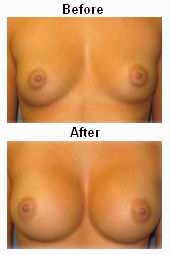
Breast augmentation is one of the most popular cosmetic surgeries, designed to enhance the size and shape of the breasts using implants or fat transfer. Patients can choose between saline, silicone, or cohesive gel implants to achieve their desired volume and feel. Fat transfer breast augmentation offers a more natural option by using the patient’s own fat, which is harvested from other areas of the body.
A woman may opt for getting her breasts augmented for various reasons.
▣ Smaller size of breast
▣ Assymetrically size or shape
▣ Drooping or Sagging of breasts due to multiple child births & breast feeding
▣ To improve the firmness of the breasts
▣ Breast reconstruction after a breast cancer surgery
Breast augmentation can be done using saline or silicone implants. The implant comes in various sizes and would be chosen based on the requirement. A Breast lift is done by removing the excess skin to provide a better shape.
The procedure followed varies from person to person and depends on the patient requirement. Your surgeon will discuss all implant options with you prior to surgery.
Breast implants are placed either under the chest muscle (submuscular) or directly behind the breast tissue (subglandular), depending on the patient's body type and goals. The procedure typically takes about one to two hours and is done under general anesthesia. Recovery time ranges from several days to a few weeks, with most patients returning to their regular activities within a week.
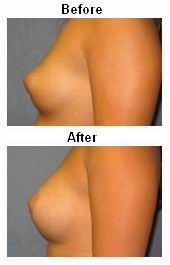
There are several potential complications and risks associated with this procedure.
▣ Infection though rare can occur within days or weeks after surgery.
▣ Contraction of the implant can occur with a capsular formation around the implant during the healing process. This compresses the implant which could leqads to a distorted look.
▣ Symmastia also known as "breadloafing"can occur in women with chestwall deformities. This can happen at anytime after surgery from a few days to several months.sia or an epidural may be used in some cases.
It's very important that you follow your surgeon's follow-up care for the incision site. There would be swelling and tenderness on the breasts after the surgery. Over time the incision scars fade off and the breasts take a more natural shape. Your breasts will be covered with a bandage of gauze or a suitable surgical bra for some time to aid in healing.
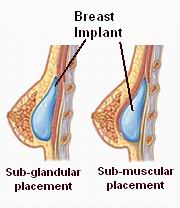
Breast implant surgery is a procedure in which a silicone shell is implanted into the breast. An incision is made Breast implant in the crease of the armpit, beneath the nipple, underneath the breast or in the abdomen to insert the implant. The incision is made with a special instrument which helps create a space for the implant. A bandage will be applied over your breasts for two days after surgery to speed up healing.
All breast implants utilize a silicone shell but contain different kinds of filler, gel or saline. The outer silicone shell may be smooth shiny and polished, or a slightly rough texture. Breasts augmented with the textured implants are less likely to develop contracting capsules than those with the smooth implants.
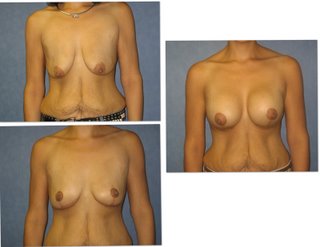
There are two techniques adopted for placing implants. The options are discussed between the patient and the surgeon prior surgery to adopt the most suitable one. The implants can be placed under the breast tissue and over the chest muscle or under the chest muscle and breast tissue.
The procedure takes approximately one hour and is done under local anaesthesia with sedation or general anaesthesia. The surgeon will decide the most suited in consultation with the patient.
All dressings and bandages will be removed on the third day following the operation following which the patient can bathe as usual. Basic exercises and movements as adviced by the doctor has to be done to improve breast contour and assist healing.
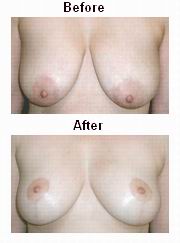
A breast lift is a surgical procedure that raises and reshapes sagging breasts to give them a firmer, more youthful appearance. This procedure is ideal for women whose breasts have lost their shape and elasticity due to aging, pregnancy, breastfeeding, or significant weight loss.
There are different techniques that can be adopted and it involves reshaping of the tissue and fat and removal of the excess skin. The operation is done with the patient asleep under general anesthesia.
The method is tailored to each patient. Incisions are made along the natural creases in the breast and around the dark pink skin surrounding the nipple (areola). A common method of surgery adopted is to mark the new nipple position. Then with the blood supply of the nipple preserved on a pedicle of tissue, the excess breast is removed. The nipple is then moved into its new position and the new breast shape is reconstructed. The incision is often around the nipple and on the under surface of the breast, like an upside down T.
The surgery takes 1 to 3 hours. After the procedure the area is wrapped in an elastic bandage or gauze dressing with surgical bra. The dressings will be replaced by a soft bra which needs to be worn for several weeks. A suitable drain is positioned to drain the fluids from the surgical area. This will be removed usually the next day.
Cold compress or ice packs are used to remove swelling if any. There may be loss of sensation around the nipple and area of incision. This would return in due course of time.

Breast reduction is a surgery done to remove fat, glandular tissue and skin from the breast. The operation usually lasts between two and four hours and takes place under a general anesthesia. Surgeons, in some cases may also use local anesthesia and sedation.
The surgeon makes an incision around the areola (the brownish area around the nipple), vertically down the breast and then along the natural crease beneath the breast. The excess tissue and skin is removed and the nipple and areola are moved into their new positions. Skin from both sides of the breast is then pulled down and around the areola, making the new shape of the breast. Any excess fat can also be removed.
In most cases, the nipples remain attached to their blood vessels and nerves as they are being moved. However, in certain cases if the breasts are very large, the nipples and areolas may have to be completely removed and grafted into a higher position - this may result in a loss of sensation in the nipples and areola. A overnight stay in the hospital is required and one would need to take approximately two weeks off work to rest.
Avoid lifting weights and physical exercise for about six weeks. It is important that the breasts are well supported by means of a firm dressing initially and then by a supportive bra. The sutures will be removed between seven and fourteen days and it is important to keep the incision sites out of the sun for one year.

Reconstruction of a breast is achieved through several plastic surgery techniques that attempt to restore a breast to near normal shape, appearance and size following mastectomy. After a mastectomy or radiation therapy insufficient tissue on the chest wall will be available to cover and support a breast implant. The use of a breast implant for reconstruction almost always requires either a flap technique or tissue expansion. A TRAM flap uses donor muscle, fat and skin from a woman�s abdomen to reconstruct the breast. The flap may either remain attached to the original blood supply and be tunneled up through the chest wall or be completely detached and formed into a breast mound.
General anesthesia is administered for this procedure.
Reconstruction with tissue expansion allows an easier recovery than flap procedures, but it is a longer reconstruction process. It requires multiple visits over 4-6 months after placement of the expander to slowly fill the device through an internal valve to expand the skin.
A second surgical procedure will be needed to replace the expander if it is not designed to serve as a permanent implant. A breast implant can be an addition or alternative to flap techniques. Saline and silicone implants are available for reconstruction.
Following your surgery for flap techniques and/or the insertion of an implant, gauze or bandages will be applied to your incisions.
Breast reconstruction is a physically and emotionally rewarding procedure for a woman who has lost a breast due to cancer or other conditions.
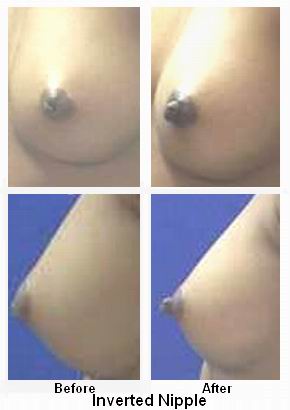
Inversion of the nipple is caused by a short milk duct system running from the chest wall to the nipple. This can be corrected through surgical procedures. There are two types of surgeries used to correct the inverted nipple: those that leave the milk ducts intact and those that do not. The objective to reshape the nipple and areola, is to make the nipple project out from the breast, enhancing the appearance of the breast while preserving sensitivity of the nipple.
Inverted nipple repair with partial preservation of milk ducts: Your doctor will administer a local Inverted Nipple Repairanesthetic as well as a sedative to help you relax. An incision will be made just around the base of the nipple on the areola.
The exact procedure depends upon the condition of the nipple. In some cases, an incision can be made in order to draw out the nipple and to have a natural protrusion. In certain cases, a nipple has to be created from the surrounding tissues. In certain cases it may be necessary to cut through the milk ducts to complete the surgery. If the surgery only involves releasing an inverted nipple, it generally takes only about half an hour to complete and may be conducted under local anesthesia.
Inverted nipple repair with detached milk ducts: This is a more common procedure and may be necessary in more difficult cases. A sedative along with a local anesthetic is administered. An incision is made at the base of the nipple and the shortened milk ducts are detached. This allows a natural-looking projection of the nipple. The incision is sutured closed, and medicated gauze is applied to the site.
The procedure takes one to two hours, depending on the technique used. Nipples and the surrounding area will be sore and swollen for two or three days after the procedure, and then decreases rapidly over the following days. Stitches are usually removed in 3 to 5 days after surgery. Basic activities can be resumed within 1 to 2 days.
As with any surgery, there are certain risks associated with this procedure. These include re-inversion, infection, injury to the tissue, excessive bleeding and reaction to anesthesia. Noticeable scars can also form after healing along with permanent pigment changes. Ther is also a chance that the nipples are not matched. There also could be changes in nipple protrusion on stimulation. In case of a nipple inversion reoccuring or a significant change in symmetry, a second procedure may be required.
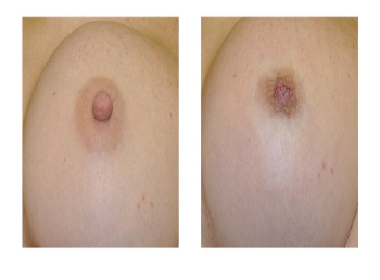
Nipple reduction surgery is sought after by women who have overly large nipples or areolas. Overly Nipple reduction surgery large nipples can cause embarrassment when erect as well as make the fitting of bras uncomfortable. A smaller nipple as well as a less prominent areola is preferred as both are less noticeable under clothing.Nipples can be enlarged, swollen or prominent in appearance, through prolonged stimulation or sexual practices which may involve pinching or pulling, tugging and piercing. Previous breast surgeries and nursing can also produce enlarged nipples. Many women request a nipple reduction because breast feeding has permanently altered the shape and size of their nipples, making them longer and somewhat droopy. Nipple reduction surgery can also be done in conjunction with areola reduction surgery. Areola reduction around the nipple can give as much aesthetic appeal as a nipple reduction.
There are a few factors that needs to be looked into to assertain whether or not a nipple is too large. A nipple that requires reduction surgery normally is long and droopy or fat and squat, also never invert and always remains in an erect condition. A nipple reduction is almost always done for cosmetic reasons as enlarged nipples rarely cause any physical discomfort. Sensation is almost always normal following a nipple reduction and the ability to breast feed can usually be easily preserved.
Nipple Reduction Surgery - Procedure
There are many methods to perform a nipple reduction surgery. A few options may include:
▣ Removing just the top of the nipple and closing it with sutures to make it shorter
▣ Removing a band of skin from the base of the nipple, pushing it back into the breast and then sealing it in that position with sutures
▣ Removing fatty tissue from beneath the areola to allow the nipple to sit deeper in the breast.
The procedure is done on an outpatient basis and is done under local anesthesia. Sedation is not required unless it is combined with other larger procedures. There may be several trips required for touch ups to attain symmetry. This procedure may also be combined with an areola reduction. Areolas require reduction when they become large, puffy and uneven in color and diameter. Sometimes this condition is caused by genetics and sometimes it is caused by trauma to the breast through sexual practices or breast feeding. In this case skin may be gathered at the point around the base of the nipples and removed as part of the overall reduction.
There are certain risks associated with nipple reduction surgery. Some of these include:
▣ Bleeding
▣ Bruising
▣ Infection
▣ Scarring
▣ Swelling
Other potential risks associated with nipple reduction surgery include:
▣ Asymmetrical results, meaning the nipples do not match in size or shape following the surgery
▣ Feeling unhappy with the results because too much or not enough tissue was removed
▣ Loss of ability to breast feed, though this complication is rare and should not occur unless the ducts are cut
▣ Loss of sensation in the nipple or breast area
Recovery after a nipple reduction is usually very rapid and usually you can return to work on the same day. Some people experience a loss of nipple sensation that lasts about a week. Since it is complex network of nerves there are chances of permanent loss of sensation as a result of surgery.
The sutures may be dissolvable or the patient may return to the doctor's office 4 to 7 days after the nipple reduction to have the stitches removed. If scars occur in the form of a lightening of the tissue where the nipple has been operated on, a procedure called areola tattooing does exist to give the affected area back its earlier shade.
This procedure cannot be reversed and hence one needs to consult with a surgeon in depth for attaining the best results.
Selecting the right surgeon is a critical part of achieving your desired results in cosmetic breast surgery. At Best Cosmetic Hospitals, we feature highly qualified, board-certified surgeons from around the world, each specializing in breast surgeries that deliver exceptional, natural-looking results.
When choosing a surgeon, here’s what to look for:
Board Certification and Credentials: Ensure that the surgeon is certified by recognized medical boards specializing in plastic and cosmetic surgery.
Experience in Breast Surgery: Choose a surgeon who has extensive experience in the specific type of breast surgery you’re considering.
Patient Testimonials and Before-and-After Photos: Read reviews and examine before-and-after galleries to see the surgeon’s work and results.
Personalized Consultation: A good surgeon will take the time to understand your goals and offer personalized treatment options based on your body type, lifestyle, and preferences.
Selecting the right surgeon is a critical part of achieving your desired results in cosmetic breast surgery. At Best Cosmetic Hospitals, we feature highly qualified, board-certified surgeons from around the world, each specializing in breast surgeries that deliver exceptional, natural-looking results.
When choosing a surgeon, here’s what to look for:
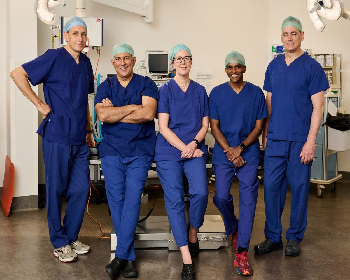
Ensure that the surgeon is certified by recognized medical boards specializing in plastic and cosmetic surgery.

Choose a surgeon who has extensive experience in the specific type of breast surgery you’re considering.

Read reviews and examine before-and-after galleries to see the surgeon’s work and results.

A good surgeon will take the time to understand your goals and offer personalized treatment options based on your body type, lifestyle, and preferences.
The recovery process for cosmetic breast surgery varies depending on the procedure but generally includes rest, wearing compression garments, and avoiding strenuous activities. Most patients experience some swelling, bruising, and discomfort immediately after surgery, but these symptoms gradually subside over the following weeks. Full recovery typically takes several weeks, after which the final results become more apparent.
The results of breast surgeries are long-lasting, with patients enjoying their new appearance for years to come. Whether you choose augmentation, a lift, or reduction, maintaining a stable weight and healthy lifestyle can help preserve your results over time.
At Best Cosmetic Hospitals, we connect you with the world’s top cosmetic surgeons, ensuring that your breast surgery is performed with the highest level of care and expertise. Whether you’re seeking a subtle enhancement or a significant transformation, our network of international hospitals and clinics is here to guide you through every step of your journey.